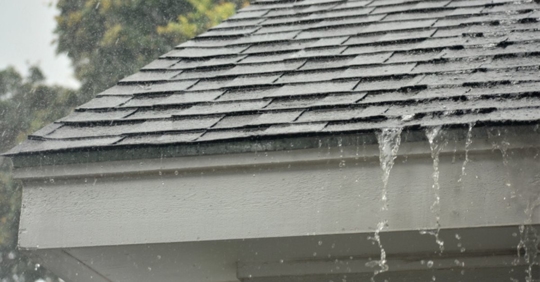The soothing sound of rain can turn into an alarming call for unwanted home visitors. With each downpour, the comforts of your indoor environment could get interrupted by pests seeking refuge from the rain. Understanding how these pests infiltrate your home when it rains can empower homeowners to take effective countermeasures and ensure a pest-free living space.
Identifying the Pathways Pests Use to Enter Homes During Rain:
Cracks and Crevices: Homes' Weak Points
Homes often harbor a myriad of weak points, especially around foundations, walls, and windows. During heavy rainstorms, these vulnerabilities become problematic entryways for pests. The relentless pressure of rain can exacerbate these cracks and crevices, providing a tempting invitation for ants, cockroaches, and even larger invaders like rodents. Experts suggest reinforcing these areas with caulking or sealants, waterproofing your home's exterior, and conducting regular inspections to identify potential breaches. By identifying and addressing these spots, homeowners can effectively retain their home's integrity against unwelcome visitors.
Tackling these weak points is more than just applying temporary fixes—it involves a proactive and preventive approach. Start by evaluating areas where water seems to linger post-rain, as these typically indicate entry points for moisture-loving pests. Engaging professional pest control services for annual assessments can provide a thorough evaluation and create a customized strategic plan. Their expert advice on sealing techniques and preventative measures ensures that homeowners stay ahead of potential infestations, turning vulnerabilities into fortified barriers.
Basement and Attic Access: High-Risk Areas
Basements and attics are notoriously known for their damp conditions, especially during the rainy season, making them key hotspots for pest invasions. As water accumulates, basements become moist havens attracting pests like silverfish and fungus gnats. Meanwhile, attics, often overlooked, offer quiet, undisturbed warmth and shelter to displaced rodents during inclement weather. To minimize pest attraction, homeowners can invest in waterproofing solutions—such as sub-floor drainage mats, sump pumps, and vapor barriers—that help maintain dryness and repel pests. Additionally, ensuring adequate ventilation in attics can deter persistent pest presence by making them less hospitable.
Conducting periodical inspections in these areas becomes vital for reducing unexpected pest encounters. If suspicion arises of infiltration, employing pest control specialists can assist in performing thorough checks and implementing preventive strategies tailored to these high-risk zones. Equipped with insights into pest-resistant materials and tailored architectural designs, these professionals transform basements and attics from pest magnets into safeguarded spaces, bolstering home defenses with reliable protective solutions.
Plumbing and Drainage Systems: Unseen Entry Routes
Rainwater significantly impacts plumbing systems, transforming them into potential pathways for pests. Often unseen and underestimated, these systems offer pests discreet routes into homes, leading to infestations. Rain can flood drains and create backflow scenarios in pipes, granting insects and rodents access to your living space. To prevent this, homeowners should regularly maintain and inspect their plumbing systems, employing anti-pest drain guards and trap systems that inhibit pest entry during rainy spells.
Maintenance strategies offered by pest control professionals can guide homeowners through effective drain hygiene practices—removing organic debris, ensuring pipe fittings remain tight, and addressing potential leaks promptly. Taking these proactive steps ensures a pest-free drainage system, reducing the likelihood of pest invasion via indoor plumbing routes. By combining expert advice with innovative pest control measures, homeowners gain confidence in their ability to protect against unwanted guests during rainy weather conditions.
Types of Pests Commonly Attracted by Rain:
Insects: From Ants to Cockroaches
Insects are the usual suspects that respond eagerly to rains, scuttling indoors for shelter and sustenance. Ants, driven by their aggressive quest to procure food, exploit entry points, while cockroaches relent their battle against damp exteriors and seek the warmth within. Homeowners can combat these unwelcome invasions by implementing natural repellents—think citrus peels or essential oils—but chemical treatments should not be overlooked when infestations get out of hand. The key is safe use, considering both the potency and potential impact on the indoor environment.
Understanding insect behavior during rainy conditions helps inform more effective treatment methodologies. Collaborating with pest control professionals provides access to an array of effective solutions that align with homeowners' needs, including eco-friendly and sustainable pesticide applications. These experts guide homeowners in creating an inhospitable environment for pests without sacrificing domestic harmony, all while aligning with responsible pest management protocols.
Rodents: Mice and Rats Making a Dash Inside
As the rain displaces rodents from their usual outdoor habitats, houses become convenient shelters where they seek food and safety. Understanding what attracts these crafty creatures—such as unsealed trash bins and accessible food sources—empowers homeowners to mitigate rodent presence. Best practices for rodent-proofing homes include strategic placement of barriers and traps, utilizing rodent-resistant materials, and designing spaces with minimal clutter to reduce hiding spots.
For more comprehensive results, consulting pest control experts ensures homeowners equip their residences with robust rodent-control strategies. They offer tailored insights into the ecological habits of rodents and suggest training sessions for homeowners that maintain vigilant behaviors in discouraging rodent incursions. Engaging these professional services offers not only immediate relief from pest pressures but also long-term security against future encroachments.
Moisture-Loving Pests: Silverfish and Fungus Gnats
Damp environments catalyze the proliferation of pests inclined to moisture—silverfish and fungus gnats being notable examples. Such pests inject irritation and disruption into homes, settling in moisture-rich zones and reproducing rapidly. Counteracting their intrusion involves understanding how to maintain optimal indoor humidity levels, utilizing dehumidifiers where necessary and maintaining well-ventilated spaces as preventive measures throughout rainy seasons.
Expert advice from pest control services aids homeowners in calibrating their indoor ecosystems to counteract moisture attraction trends. They offer a thorough understanding of environmental conditions that favor these pests and propose reliable technologies that stabilize indoor humidity effectively. Embracing their guidance guarantees a balanced interior, beneficially keeping moisture-loving pests at bay while preserving comfort within the home.
Weather Patterns and Their Impact on Pest Behavior:
Heavy Rain vs. Light Rain: Different Impacts
Rainfall intensity plays a pivotal role in influencing pest behavior, with heavier downpours often prompting pests to migrate indoors more fervently. In contrast, lighter rains might not deter them entirely outside but can spur strategic movements towards entry points. Understanding these variations empowers homeowners to anticipate pest movements and apply tactical interventions during both scenarios. Research has uncovered that pests optimize their migration tactics dynamically upon sensing rain's persistence and comprehensiveness.
Homeowners, guided by pest control experts, can fine-tune their perspectives through exposure to the latest research findings, granting them deeper insights into pest migration patterns. Such knowledge further enriches strategies targeted at curbing quick pest movement into homes, allowing for precise responses adaptable to weather shifts whenever they occur.
Climate Change: Altering Rain Patterns and Pest Activity
Climate change renders a transformative effect on rain patterns and subsequently impacts pest dynamics. Entomologists caution against the evolving rain behaviors that disrupt traditional pest habitats, speculating on pest population explosions indoors. Altering climatic conditions present challenges and opportunities for homeowners invested in preemptive pest control, slated to cope with pest trends influenced by shifts in moisture distribution, temperature variations, and unforeseen weather anomalies.
Insights from climatologists and pest professionals guide homeowners through understanding climate's impact on pest incursion risks. They propose forward-thinking strategies designed to anticipate pest booms instigated by shifting rain patterns, enabling families to create homes resilient against environmentally driven pest deluges. Their wisdom empowers a collective stance against pest uprisings, grounded in sustainable, informed, and future-ready practices.
Seasonal Rains: Predicting Pest Surges
Recognizing the seasonal rhythm of rains offers valuable cues in predicting pest surges and intensifying preventive measures accordingly. Different seasons bring distinct rain patterns that influence pest behavior uniquely, guiding homeowners to anticipate pest activities synchronously with weather trends. Entomologists indicate that seasonal preparedness—undertaking targeted interventions upon anticipating specific seasonal rains—enhances home resilience against pest waves.
Leveraging guidance from local pest control services, homeowners can implement cyclical strategies acclimatized to seasonal rain characteristics. This collaboration provides home protection that flexibly aligns with changing seasonal pest expectations, enhancing preparedness and encouraging a streamlined pest management protocol that correlates harmoniously with annual rainfall variations.
Preventative Measures to Mitigate Pest Invasion During Rain:
Landscaping: A Natural Barrier Against Pests
Effective landscaping acts as a natural barrier, discouraging pest infiltration during rain. By devising strategically designed outdoor environments—incorporating pest-repellent plants and maintaining proper ground conditions—homeowners create inviting yet impenetrable boundaries that deflect pest encroachments. Regularly trimmed grass and appropriately applied mulch contribute significantly to protective landscapes endorsed by experts.
Pest control specialists foster innovative landscaping approaches that enhance residential defenses against pest invasions amidst rainy weather. Their insights into plant selection—choosing species inherently deterring pests—reinforce homeowners' external defenses while enriching aesthetic outdoor appearances in an eco-conscious manner.
Home Maintenance: Keeping Pests at Bay
Routine home maintenance, focusing on pest-proofing tasks, becomes crucial in safeguarding homes from pest entry during rain. Gutter cleaning, roof inspections, siding checks, and frequent evaluations of vulnerable zones protect homes from both immediate and long-term pest threats. These practices serve as layers of fortification that ensure the atmosphere within continues to remain uninterrupted by external intrusions.
Professional inspections conducted by local pest control services offer quality assurance and preventative measures. Their sights are set on eliminating potential pest pitfalls well before rains heighten vulnerabilities, enabling homeowners to ensure durable pest-proof defences that merge effortlessly with consistent home maintenance rituals.
Technology and Tools: Innovations in Pest Prevention
Today's technological advancements provide exciting innovations in pest prevention. From smart home devices equipped to detect pest activities to apps capable of tracking pest patterns, these tools furnish contemporary homeowners with unprecedented access to effective monitoring strategies. Digital infrastructures, aligned with preventive measures, shape a tech-assisted deterrence anchored in real-time pest insights.
Pest control professionals supply in-depth technological advice, assisting homeowners in integrating cutting-edge tools to elevate pest prevention capabilities. Navigating available technology optimally, homeowners inspire a paradigm shift favoring advanced pest control solutions that synchronize with burgeoning needs to thwart pest disturbances heightened by rainy conditions.
Addressing Reader Concerns:
How to Identify Early Signs of Pest Intrusion?
Early detection of pest activity is vital for intercepting infestations before they become entrenched within household boundaries. Homeowners can look for these indicators post-rain: odd noises emanating from walls or ceilings, peculiar smells, unexplained debris piles, and physical sightings of isolated pests. A visual examination checklist, coupled with input from pest control professionals can maximize effective early detection.
Sharing insights on pest behaviors and preventive checks facilitates immediate identification protocols when rainfall strengthens pest presence. Expert recommendations streamline detection methods, equipping homeowners with practical approaches that nurture advanced awareness against pest intrusions silently plotted during wet weather.
What Are Cost-Effective Solutions for Pest Control?
Cost-effective pest control options abound, offering homeowners budget-friendly methods without compromising effectiveness. DIY approaches—such as homemade traps and natural repellents—constitute primary solutions. Including over-the-counter treatments extends financial viability for broader pest prevention scopes. Crushing costs with practical strategies warrants cautious evaluations, comparing homemade solutions against costs incurred when engaging professional pest control services.
Pest control professionals offer clarity on frustration-free payment plans when utilizing expert routines designed for challenging pest confrontations. This synthesis of fiscal prudence and effective pest management empowers homeowners toward comprehensive strategies finely tuned to address pest concerns precipitated by rainy seasons, leveraging economical savvy against exuberant intrusions.
How Do Environmental Factors Affect Pest Populations?
Environmental conditions, including pesticide application, habitat alteration, and seasonal fluctuations, carry profound impacts on pest populations during rain. Studying these elements imparts wisdom on how ecosystems engaging pests thrive. Ecologically conscious pest management protocols focus on sustainable practices that account for interactions between pests and evolving environmental dynamics.
The commitment to embracing eco-friendly approaches facilitates pest management methods respectful of natural habitats disrupted by rains. Pest control professionals deliver integrative solutions that minimize ecological footprints while preserving homeowners' quest for shelter within peaceful rain-impacted environments, aligning with desired outcomes against pest prevalence. With expertise guiding eco-principles, homeowners create protective cores that resonate with environmental stewardship.
CS content tokens Frame's Pest Control, Inc. or (877) 803-5966
Taking control of pest prevention not only guards your home but also supports a harmonious coexistence with nature. If you're experiencing pest problems after the rain or want to be well-prepared for upcoming stormy weather, contact Frame's Pest Control, Inc. for expert advice and services tailored to your needs.
Call Frame's Pest Control, Inc. now at (877) 803-5966 or send us a message online.


